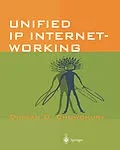Unified IP Internetworking is the best resource for building intranet and enterprise networks today. Using the newly revived Internet Protocol (IP) design, dynamic bandwidth allocation, traffic class identification, service level agreement, multiservice transport and quality of service are now all possible. This book examines the power and flexibility of the IP in meeting these and future challenges while providing step by step explanations and testing techniques for building a network.
Inhalt
1 IP Internetworking.- 1.1 Introduction.- 1.2 Internet Engineering Task Force (IETF).- 1.3 Layer 3 Switch.- 1.4 IP Addressing.- 1.4.1 Subnetting.- 1.4.2 Variable Length Subnet Mask (VLSM).- 1.4.3 Classless Interdomain Routing (CIDR).- 1.5 NAT (Network Address Translation).- 1.5.1 Static Address Mapping.- 1.5.2 Dynamic Address Translation.- 1.5.3 Port Address Translation (PAT).- 1.6 IPv4.- 1.6.1 ARP (Address Resolution Protocol).- 1.6.2 RARP (Reverse Address Resolution Protocol).- 1.6.3 BOOTP.- 1.7 IPv6.- 1.7.1 IPv6 Header Format.- 1.7.2 IPv6 Addressing Architecture.- 1.7.3 IPv6 Transmission.- 1.7.4 Transition Criteria.- 1.7.5 IPv6 Tunnel.- 1.7.6 ICMPv6.- 1.7.7 Address Autoconfiguration.- 2 Routing Technologies.- 2.1 Introduction.- 2.2 Routing.- 2.2.1 Routing Tables.- 2.2.2 Routing Protocols.- 2.3 RIP (Routing Information Protocol).- 2.3.1 Message Format.- 2.4. OSPF Protocol.- 2.4.1 Dijkstra SPF Algorithm.- 2.4.2 OSPF Concept.- 2.4.3 Basic Operation.- 2.4.4 OSPF Message Format.- 2.5 Border Gateway Protocol (BGP).- 2.5.1 BGP Analysis.- 2.5.2 BGP-2 Message.- 2.5.3 BGP-3.- 2.5.4 BGP-4.- 2.5.5 BGP-4 Routes Advertisement and Storage.- 2.6 Multi-Protocol Label Switching (MPLS).- 2.6.1 MPLS Overview.- 2.6.2 MPLS Basics.- 2.6.3 Label Distribution Protocol.- 3 IP and Policy Services.- 3.1 Introduction.- 3.2 IP QoS.- 3.2.1 First-in, First-out (FIFO).- 3.2.2 Weighted Fair Queuing (WFQ).- 3.2.3 Custom Queuing (CQ).- 3.2.4 Priority Queuing (PQ).- 3.3 IP Datagram.- 3.3.1 IP Options.- 3.3.2 Padding.- 3.3.3 IP Precedence and TOS Byte.- 3.4 QoS Architecture.- 3.4.1 IntServ.- 3.4.2 DiffServ.- 3.4.3 IntServ and DiffServ Comparison.- 3.5 COPS (Common Open Policy Service).- 3.5.1 COPS Message Format.- 3.5.2 COPS Operation.- 3.5.3 COPS Message Exchange.- 3.5.4 COPS-PR.- 3.5.5 COPS-RSVP.- 3.6 PEN.- 4 Voice over IP.- 4.1 Introduction.- 4.2 Wave Phenomenon.- 4.2.1 Modulation.- 4.2.2 Codec.- 4.3 POTS.- 4.3.1 Telephony.- 4.3.2 The Telephone.- 4.3.3 Transmission.- 4.3.4 Satellite Telephony.- 4.3.5 Signaling.- 4.4 VoIP Overview.- 4.4.1 Layered Architecture.- 4.5 H.323 Protocol.- 4.5.1 Terminals.- 4.5.2 Gateways.- 4.5.3 Gatekeepers.- 4.5.4 Multipoint Control Units (MCUs).- 4.6 RTP (Real-Time Transport Protocol).- 4.7 VoIP Operational Environment.- 4.7.1 ITU-T Message Exchange.- 4.7.2 Voice Quality.
